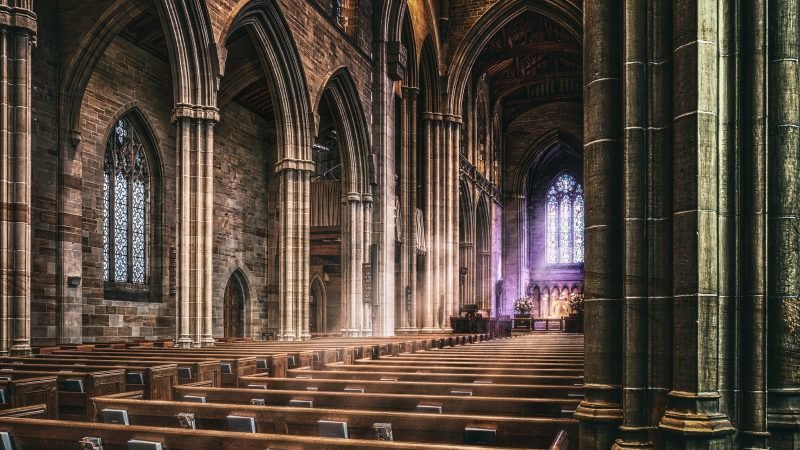Editor’s note: This is one of two viewpoints presented. Click here for the opposing view.
The standard approach to worship today often says, “If it makes me feel good, then it must be good”. There is an underlying assumption that, “if it helps me feel God’s presence [whatever that means] it must be pleasing to God.” However, we should not imagine that worship that is contrary to God’s word is in any way pleasing to him. What, then, should we make of images of Christ in worship? Some argue that, if people enjoy these images, if they “work” for them, then they must be acceptable to God. Today, few have considered the implications of the Second Commandment and whether images of Christ in worship are, in fact, offensive to God.
God gave the command to the Israelites at Mount Sinai in Exodus 20:4-5, saying, “You shall not make for yourself a carved image, or any likeness of anything that is in heaven above, or that is in the earth beneath, or that is in the water under the earth. You shall not bow down to them or serve them, for I the Lord your God am a jealous God …” This commandment not only forbids the worship of false gods through images, but also forbids worshiping the true God through images. There is one invisible God, and he is not to be depicted and worshiped in images of created things. Even John of Damascus—a staunch defender of images in worship—agreed that, “if we attempted to make an image of the invisible God, this would be sinful indeed”.1 The surpassing glory and majesty of God is not able to be captured in even the most beautiful images, and any image that attempts to portray the invisible God inevitably diminishes his glory.
The narrative of Aaron and Israel making and worshiping the golden calf indicates that Aaron was not condemned for considering the calf a separate and distinct god but, rather, for worshiping the calf as a false image of the true God who had brought them up out of Egypt.2 All worship of the invisible God through physical images is false worship.
However, we must seek to understand the Second Commandment with nuance, not going further than what it demands. There is a distinction to be made between images and idols. The Second Commandment cannot intend to ban all images used in worship because God expressly commands the use of some images in worship. The cherubim on the ark of the covenant, the bronze serpent in the wilderness, and the elaborate decoration of the temple are just a few examples.3
The bronze serpent in particular serves as an exceptional case in point. God commanded the image be made after the people had sinned and he sent a plague of venomous snakes as punishment. When the people turned to the image of the snake and gazed upon it, they were healed. This turning and reverencing the snake for healing was not idol worship but, rather, proper worship of the one true God. Even more specifically, the snake was a type that pointed to Christ. Later in the time of Hezekiah, the people had begun worshiping the bronze snake and burning incense to it. Hezekiah rightly broke it to pieces to stop the people’s idolatry and false worship. We see that God condemns the misuse of images in worship and not their mere presence in worship.
We might understand this more clearly by drawing a distinction between conventional and real symbols. A real symbol “is a visible object that represents something invisible, something present representing something absent … He who has the image has the god”.4 The image that is a real symbol is understood to somehow host the presence or essence of its prototype. Images that are real symbols are by their nature idols when used in worship.
A conventional symbol “represents a reality not because it possesses the inherent qualities of that reality, but because of the association, relationship, or convention suggested by it”.5 These images are not outlawed in the Second Commandment. No one ought to think the cherubim on the ark are real cherubim. No one confuses the American flag with the United States of America. We don’t think that a picture of a person is, in reality, the person represented or that it somehow hosts their presence.
So, we see that the Second Commandment was not given to preclude all images in worship, lest we accuse God of giving contrary commands. The Second Commandment forbids all images of the invisible God and all real (rather than conventional) symbols in worship.
How then should we approach images of Christ in worship? Are they banned alongside any depictions of the Father? I think not. In the old covenant, God revealed himself behind a veil of clouds. But in Jesus and the establishment of the new covenant, he has revealed himself in physical form. Jesus is the image of the invisible God.6 As such, what was once beyond depiction has now been revealed, so that to see Jesus is to see God.7 Making an image of the Father is still not permissible, but to make an image of the Son who has revealed himself in flesh, is permissible. Even David VanDrunen—a firm iconoclast—agrees that “an authentic image of Christ is ontologically possible,” so that an accurate image of Christ would be possible and permissible.8 As John of Damascus states, “when the invisible one becomes visible to flesh, you may then draw his likeness”.9
It is essential to make another distinction here, this time between images and their prototypes. An image of Christ cannot be confused with the real Christ. Many iconoclasts through history have understood images and prototypes as having the same essence, so that every image of God, including an image of the Son, is an idol. However, there are always differences between an image and its prototype.10 The prototype is always the reality and possesses all of its qualities. The image is associated with the prototype and may possess some of its qualities, but never all of them. Some iconoclasts today allow for the possibility of images of Christ but claim that the only permissible images of Christ must be perfect depictions of the likeness of Christ without error. Yet, even the most high-quality photograph of a person would fail to depict the prototype with perfection. Zoom in enough and the pixilation or brush strokes will become visible. But images are not required to perfectly represent their prototype; in fact, by definition, they cannot. A father is not offended by his child’s drawing of him despite its relative (and perhaps extreme) inaccuracies. There may be few similarities between an image and its prototype. However, the father does not need to go about clarifying his child’s drawing and shouting, “That’s not really me!” Of course not. It’s an image of him.
Images of Jesus break the Second Commandment when they are treated as being one with their prototype, as if a physical manifestation of the presence of Jesus was really present or hosted in the image. The image is nothing in itself. However, if they are seen as conventional images distinct from their prototype, they are permissible.
So, what benefit is there in using images of Christ in worship? Are they a proper element of worship or themselves a means of grace? Those who defended the use of images in the 700’s and 800’s erroneously demanded that images of Christ were not only permissible but also required in worship! Therefore, the use of images was elevated to an essential element in worship, and to not use images in worship was considered false worship. Not only are images of Christ not essential elements in worship, but they also have no benefit in themselves to spiritually strengthen the worshipper.
While images of Christ do not sanctify us, they may turn us more zealously and readily to the ordinary means of grace which God has instituted. Consider the Book of Common Prayer. It is a helpful tool that should neither be commanded nor outlawed in worship. It points us to the ordinary means of grace, but is not an essential element of worship nor a means of grace in itself. Just as the Book of Common Prayer is not a benefit in itself in worship but a useful tool, so also are images of Christ to the worshipper.
Because the invisible God has revealed himself in physical form, images of Christ, when used as conventional symbols and recognized as distinct from their prototype, are permissible in worship. Images of Christ can be helpful tools in worship that point us to the ordinary means of grace without themselves being means of grace. As John of Damascus states, “We do not embrace the cross as our God, but the position of our bodies shows what our souls sincerely feel toward him who was crucified.”11
- John of Damascus. On the Divine Images. Translated by David Anderson. Crestwood, New York: St. Vladimir’s University Press, 1994. 52. ↩︎
- See Exodus 32:4. ↩︎
- See Exodus 37:1-9; Numbers 21:4-9; and 1 Kings 6:23-35. ↩︎
- Victor P. Hamilton. Handbook on the Pentateuch, 2nd ed. (Grand Rapids: Baker Academic, 2005), 192. ↩︎
- Ibid., 192. ↩︎
- See Colossians 1:15. ↩︎
- See John 14:9. ↩︎
- David VanDrunen. “Iconoclasm, Incarnation and Eschatology: Toward a Catholic Understanding of the Reformed Doctrine of the ‘Second’ Commandment.” International Journal of Systematic Theology 6, no. 2 (2004): 139. ↩︎
- John of Damascus, 18. ↩︎
- Ibid., 74. ↩︎
- Ibid., 104. ↩︎



This is an excellent, thoughtful article. I am intrigued by the distinction made between “real” and “conventional” images. I shall be looking forward to reading the opposing article when it is published.